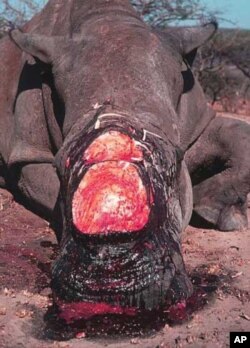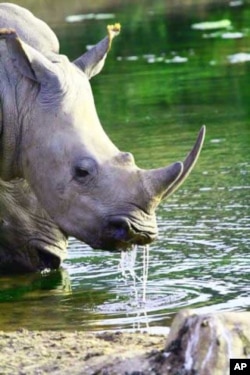In 2011, in a matter of weeks, four rhino were butchered on three private game reserves in a small area of South Africa’s Eastern Cape province, and conservationists realized the high level of sophistication that the poachers had reached in their pursuit of massive profits from rhino horn sales in Asia.
“All of the rhino were injected with veterinary drugs to sedate them and their horns [were] sawed off,” said Jennifer Gush, a zoologist at the Amakhala park, which lost two rhino to poachers. “Rhino owners in this area have excellent security but in all these cases, no one heard or saw anything suspicious. We believe highly trained professional poachers got into our reserves under cover of darkness and used infra-red night vision and heat sensors to find and target our rhino.”
Just a few years ago, said rhino owner and conservationist Iain Stewart, the poachers were “very primitive. They’d simply sneak into our reserves and try to shoot animals dead with whatever firearms they had. They would often just wound animals.”
But now, he said, the criminals never miss their targets – resulting in an all-time high for rhino killings in South Africa. The country’s environmental authorities confirmed that in the past five years poachers killed more than 1,000.
“They’re now not actually shooting the rhino with proper bullets; they’re darting the rhino and overdosing them to death…with a drug called M99 – it’s a veterinary drug. It’s a schedule 7 (prescription) drug, so there have to be doctors and vets involved,” said Stewart.
Entry of organized crime
Up until recently, said international wildlife trade investigator Tom Milliken, traders would recruit poor people who lived around areas that contained rhino and would pay them relatively little to get horns “by whatever means possible.”
But now, he added, “There’s a new breed of poacher out there, and that breed is very different from indigent Africans living in poverty. They’re white professional wildlife experts. They’re wildlife veterinarians and professional hunters and even game ranch owners themselves who are poaching their neighbors’ rhino.”
In the past few months, South African law enforcement authorities have arrested a number of game ranchers, hunters and veterinarians for alleged involvement in poaching.
Milliken said the implication in the crime of previously “highly respected” players in South Africa’s wildlife industry offered further evidence that organized criminal syndicates, who are also involved in international drug and weapons trafficking, are now controlling the illicit trade in horn.
“They’ve entered this market because suddenly there’s big money to be made there,” said Milliken, who works for Traffic International, an organization that monitors trade in animal products. According to the International Rhino Foundation, horn currently costs about $57,000 a kilogram on the black market in Asia.
The price has skyrocketed following unsubstantiated reports in recent years that several well-known public figures in Asia, including politicians and celebrities, were cured of cancer by ingesting ground horn. Scientists say it has no curative value.
“The syndicates are making big money from rhino horn and so they’re able to pay unscrupulous and greedy vets big money to help them get hold of rhino in a much more efficient way,” explained Damien Mander, director of the International Anti-Poaching Foundation based in Zimbabwe.
Military links
Lucy Boddam-Whetham, deputy director of Save the Rhino International, said rich”and “really serious criminal gangs” are able to afford the latest technology and military equipment to allow them to poach “to a degree of efficiency never seen before. They have AK-47 guns, they have darting equipment; they use helicopters and night vision equipment. It’s really scary stuff; it’s not just snaring and opportune poaching anymore. It’s really organized, which is the real scare.”
Wildlife reserve manager Alan Weyer said it is the poachers’ use of “superfast, military-style” helicopters that had “really upped the ante” in the battle to save the rhino. He said criminals used such an aircraft to kill one of his.
Weyer told VOA, “On big reserves like in South Africa, even if you see the helicopter landing, you haven’t got much hope against the poachers. From when they dart that animal from the helicopter to when they take off with the horn it’s about seven minutes. On a 9,000 hectare reserve like we’ve got here, you have [no] hope of getting there [in time] to stop that.”
Former soldiers: ‘perfect poachers’
Many in the wildlife industry are convinced that criminal syndicates are recruiting people with military training to kill rhino.
“Look at all the guerilla wars that have happened in southern Africa in the recent past – in Zimbabwe, Mozambique, Angola, Namibia and South Africa,” said Dale Howarth, a conservationist who owns the Pumba private game reserve. “The people who fought in those wars know how to survive in the bush. Many of them are unemployed. They are perfect recruits for the poaching networks.”
South African security forces have arrested scores of Mozambicans and Zimbabweans for allegedly killing rhino. Officers investigating recent poaching confirmed that weapons used in Mozambique’s civil war, which raged from the late 1970s to the early 1990s, had been recovered in the epicenter of poaching in South Africa, the Kruger National Park, after a shootout between members of South Africa’s National Defense Force and suspected poachers.
Gush said there is also “strong reason” to believe that some of the poachers are former members of South Africa’s elite military reconnaissance unit. The unit was disbanded when apartheid ended in 1994. They are trained to operate undetected behind enemy lines, are respected for their physical and mental strength and are able to endure long periods without food or sleep.
“It’s quite possible that somebody with Special Forces training comes into the reserves and spends two or three days in the bush. You don’t see them, they have really good bush skills, and that’s how they locate the animals,” she explained.
Milliken said it is “generally very simple” for criminals to get the horns out of South Africa and into Asia. “They’re being flown out in the personal effects and luggage that an ordinary passenger would put onto a plane. Your carry-on luggage, for example, could easily mask several rhino horns. On numerous occasions at Johannesburg International Airport individuals have been found with rhino horns in their luggage.”
He said the horns are also shipped out of South Africa. Hong Kong authorities recently seized 33 horns and an assortment of ivory. The products had arrived on a ship from Cape Town in containers that were supposed to hold plastic waste for disposal in China.
Vietnamese criminals exploit hunting loophole
Many of the more than 200 people arrested in South Africa in 2011 for the illicit trade were Vietnamese citizens who allegedly entered the country under the guise of being trophy hunters.
The South African government allows foreign hunters to shoot some white rhino in what it refers to as “controlled hunts,” because the hunting of the rare animals generates a lot of income for the state. According to several sources in South Africa’s hunting industry, it costs between $30,000 and $40,000 to hunt a single white rhino. The South African Revenue Service said foreign hunters spent almost $100 million every year in South Africa.
The licensed hunters are permitted to export the horns of rhino they’ve shot, to mount on their walls back home as trophies. But Kirsty Brebner, who manages the Rhino Security Project at South Africa’s Endangered Wildlife Trust, said the “so-called hunters” were in fact criminals who sold the horns on the black market.
“The sport hunting industry in South Africa does have a legal avenue to hunt white rhino,” Milliken told VOA. “Previously we never believed that this could become a way for criminals to procure rhino horn because the cost of a hunt was far more than the value of a horn. But with the escalating prices of horn in Asia, suddenly it is economically viable to acquire rhino horn through a sport hunt. So suddenly out of the blue all these Vietnamese have shown up in South Africa.”
He has data to show that over the last three years, 69 percent of the sport hunts in South Africa have involved Vietnamese citizens.
“I think this screams very loudly that this is not hunting as we’ve ever seen it. This is really an avenue of commercial trade. And this is one of the major lapses of the South African government – that the penny didn’t drop and it didn’t realize that perhaps these aren’t bona fide hunters,” Milliken commented.
South African authorities have pledged to close what they refer to as the “hunting loophole” that has allowed criminals to get their hands on rhino horn.
Milliken said he told Vietnamese government officials, in meetings with them, “If you want to know who is marketing illegal rhino horn in your country, just look at the list of individuals who have recently sport hunted in South Africa. He said they have names and passport numbers and are easy to trace.
“What’s happened to those horns that they allegedly have brought out of South Africa back to Vietnam? If they are not able to produce those horns as legitimate trophies, then it’s a clear indication that these are the very criminals that are illegally selling rhino horn throughout Vietnam.”
Milliken said Vietnamese authorities promised to launch the necessary investigations. “We’ll have to wait and see what happens,” he added.
The ‘kingpin’
Some of the “hunters” arrested in South Africa in 2011 were also from Thailand.
“Thailand is the biggest hub of illegal wildlife trade in southeast Asia,” said Milliken. “The consumption of rhino horn isn’t going on in Thailand. It’s just that Thai criminals are involved because they have extensive experience in illegal wildlife trade, so they have the global connections to allow them to move rhino horn and other commodities, like ivory.”
A Thai man described by South African police as a “kingpin” of the illegal trade in horn, Chemlong Lemthongai, is currently awaiting trial in Johannesburg. He allegedly used hunting permits to illicitly export horns to Asia. Police said Lemthongai’s syndicate is responsible for killing at least 40 of the animals in South Africa in 2011 and placed an order for 50 more to be supplied by the end of the year.
The police said Lemthongai paid Thai strippers and sex workers operating in South Africa to pose as hunters so that, through them, he could acquire the documentation necessary for him to fulfill his order.
Chinese rhino horn pills
Milliken said there is a growing body of evidence that Chinese criminals are now actively involved in the illegal trade. “We know that the Chinese are involved because there have been a number of rhino horn seizures made recently in China,” he pointed out.
Milliken said there was another recent development in China that caused “extreme concern” among rhino conservationists. He explained that South Africa had in the past few years exported more than 100 live white rhino to China, ostensibly for display in zoos there.
In reality, said Milliken, most of the rhino were imported by a Chinese arms company that also has a pharmaceutical wing called Long Hui. According to the firm’s business plan, it wants to begin captive breeding of rhino to harvest the animal’s horns in order to manufacture pills that would bring it an annual profit of $60 million.
Long Hui’s proposal is under consideration by the Chinese government.
“The case has signaled that some Chinese are bent on commercial trade of horn. The Chinese government has said that they are not changing the ban they have had in effect since 1993 on the use of rhino horn in traditional medicines. We are hoping that will stay,” said Milliken.
But he added that the arms company had “a lot of political clout” as it was headed by a prominent member of China’s ruling party. “As such, we remain concerned that there could be plans afoot to overturn the ban,” said Milliken.
If that happened, it would be yet another setback for rhino conservationists who are still reeling from a period the Endangered Wildlife Trust’s Kirsty Brebner described as “one of the darkest ever” in the history of efforts to save the world’s last remaining rhino.











